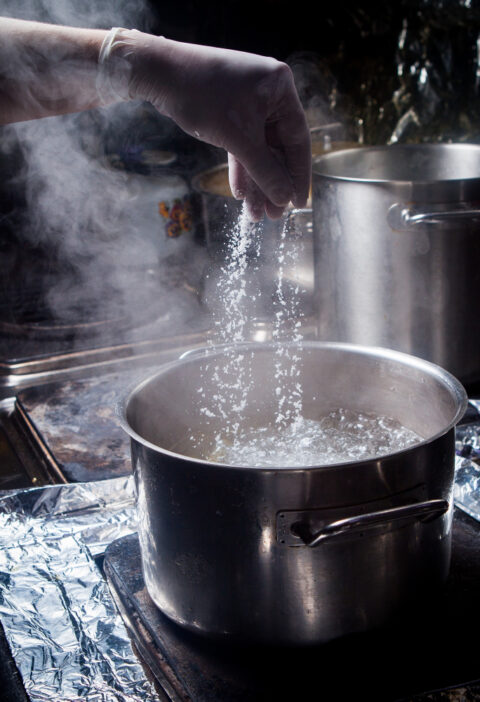Mastering knife skills is essential for efficient, safe, and enjoyable cooking. Here’s a guide to help beginners learn basic knife skills and techniques.
1. Choosing the Right Knife
Choosing the right knife depends on various factors such as the intended use, blade material, handle design, and your level of experience. Here’s a guide to help you make an informed decision:
1. Purpose
The primary factor in choosing a knife is its intended use. Different tasks require different types of knives:
- Chef’s Knife: Versatile and ideal for most kitchen tasks like chopping, slicing, and dicing vegetables, fruits, and meats.
- Paring Knife: Small and precise, perfect for peeling and intricate work like deveining shrimp or cutting small garnishes.
- Bread Knife: Long with a serrated edge, designed for slicing bread without crushing it.
- Utility Knife: A mid-sized knife useful for miscellaneous tasks where a chef’s knife might be too large.
- Boning Knife: Narrow and flexible, ideal for deboning meat and poultry.
- Santoku Knife: Japanese all-purpose knife similar to a chef’s knife but typically lighter and shorter, suitable for slicing, dicing, and mincing.
2. Blade Material
The material of the blade influences its sharpness, durability, and maintenance:
- Stainless Steel: Resistant to rust and easy to maintain, but may require more frequent sharpening.
- Carbon Steel: Holds a sharp edge longer and is easier to sharpen but prone to rust and discoloration if not properly maintained.
- High Carbon Stainless Steel: Combines the best of both stainless and carbon steel, offering good edge retention and rust resistance.
- Ceramic: Extremely sharp and retains its edge for a long time, but can be brittle and prone to chipping or breaking.
3. Blade Edge
The edge type affects the cutting performance:
- Straight Edge: Versatile and good for clean cuts.
- Serrated Edge: Ideal for cutting through tough or fibrous materials like bread or tomatoes.
- Granton Edge: Features dimples along the blade to prevent food from sticking, useful for slicing meats and fish.
4. Handle Design
The handle should provide comfort, control, and safety:
- Wood Handles: Offer a traditional look and feel, but require more maintenance to prevent cracking and bacteria buildup.
- Plastic Handles: Durable and easy to clean, but may become slippery when wet.
- Composite Handles: Made from a mix of materials, they offer a balance of durability, grip, and aesthetics.
- Metal Handles: Extremely durable and easy to sanitize, but can be heavy and less comfortable over extended use.
5. Balance and Weight
A well-balanced knife ensures better control and reduces fatigue:
- Balance: The knife should feel balanced in your hand, with neither the blade nor the handle feeling disproportionately heavy.
- Weight: Heavier knives can make cutting easier by providing more force, but lighter knives offer better control and precision.
6. Price and Brand
Consider your budget and research reputable brands:
- Budget: While high-end knives can be quite expensive, many mid-range knives offer excellent performance and durability.
- Brand: Trusted brands often provide better quality control and customer service. Examples include Wüsthof, Shun, Global, Victorinox, and Zwilling J.A. Henckels.
Conclusion
When choosing a knife, consider what tasks you will use it for most frequently, the blade material and edge, handle design, balance, weight, and your budget. It’s often beneficial to try holding different knives to see what feels most comfortable in your hand before making a purchase. Investing in a good-quality knife can enhance your cooking experience and improve efficiency in the kitchen.
- Chef’s Knife: Versatile and ideal for most tasks such as chopping, slicing, and dicing.
- Paring Knife: Small and great for precision tasks like peeling and trimming.
- Serrated Knife: Perfect for cutting bread, tomatoes, and other soft or crusty foods.
2. Proper Grip
Details:
- Pinch Grip: Hold the knife handle with your thumb and forefinger pinching the blade just before the handle. This gives better control and balance.
- Handle Grip: Wrap all your fingers around the handle. This grip is less stable than the pinch grip but more comfortable for some.
3. Cutting Techniques
1. Chopping
Details:
- Technique: Use a rocking motion with the knife’s tip always touching the cutting board.
- Use: Suitable for vegetables, herbs, and nuts.
- Tip: Keep your knuckles against the blade for guidance and protection.
2. Slicing
Details:
- Technique: Use a smooth, back-and-forth motion, letting the knife’s sharpness do the work.
- Use Ideal for cutting meat, fish, fruits, and vegetables.
- Tip: Keep slices even for consistent cooking times.
3. Dicing
Details:
- Technique: First, slice the food into even strips, then cut those strips crosswise into cubes.
- Use: Perfect for onions, potatoes, and other vegetables.
- Tip: Ensure uniform pieces for even cooking.
4. Julienne
Details:
- Technique: Cut the food into thin, matchstick-sized pieces.
- Use: Common for carrots, cucumbers, and peppers.
- Tip: Stack slices to make cutting faster and more uniform.
5. Mincing
Details:
- Technique: Chop food into very fine pieces by repeatedly moving the knife over it.
- Use: Great for garlic, herbs, and ginger.
- Tip: Gather food into a pile and continue chopping until finely minced.
4. Knife Safety Tips
Details:
- Sharp Knife: Always use a sharp knife to reduce the risk of slipping and to make cutting easier.
- Stable Cutting Board: Use a damp cloth under the cutting board to prevent it from sliding.
- Claw Grip: Hold the food with your non-dominant hand, curling your fingers inward to protect them.
- Focus: Pay attention while cutting, and never rush.
5. Knife Maintenance
Details:
- Honing: Regularly hone your knife with a honing steel to maintain its edge.
- Sharpening: Sharpen your knife using a whetstone or professional service when it becomes dull.
- Cleaning: Hand wash your knives with mild soap and water, then dry them immediately to prevent rusting.
- Storage: Store knives in a knife block, on a magnetic strip, or in a protective sheath to keep them sharp and safe.
6. Practice Drills for Beginners
1. Onion Dicing Drill
Steps:
- Cut the onion in half and peel it.
- Make horizontal cuts, keeping the root intact.
- Make vertical cuts towards the root.
- Finally, chop across the onion to create dice.
2. Carrot Julienne Drill
Steps:
- Peel the carrot and cut it into 2-3 inch segments.
- Slice each segment lengthwise into thin slabs.
- Stack the slabs and cut them into matchsticks.
3. Herb Mincing Drill
Steps:
- Gather a bunch of herbs like parsley or cilantro.
- Use a rocking motion to chop them finely.
- Gather the herbs into a pile and continue mincing until fine.
Visual Aids and Videos
Watching videos and practicing alongside visual aids can be incredibly helpful. Look for tutorials that demonstrate these techniques in action.
By practicing these knife skills and techniques, beginners can improve their efficiency and safety in the kitchen, making the cooking experience more enjoyable and productive.


